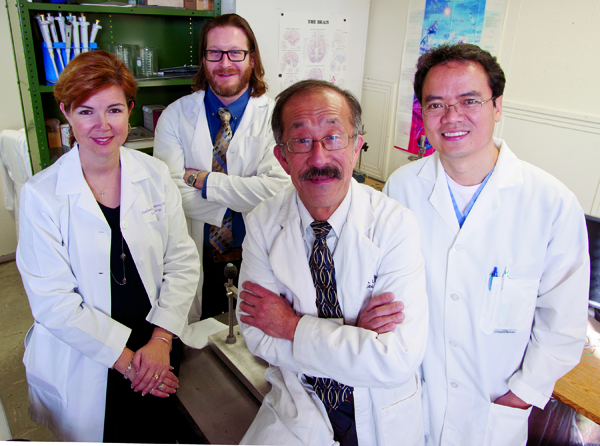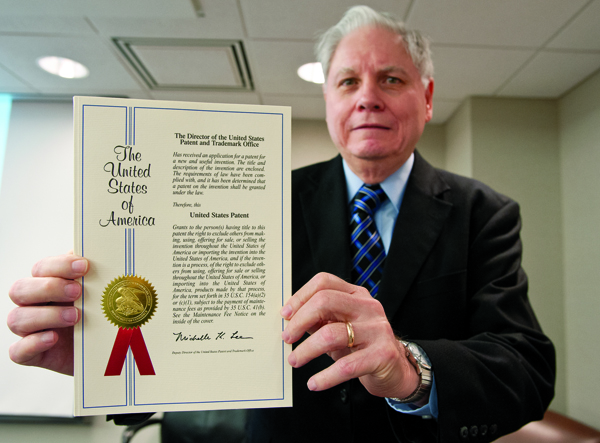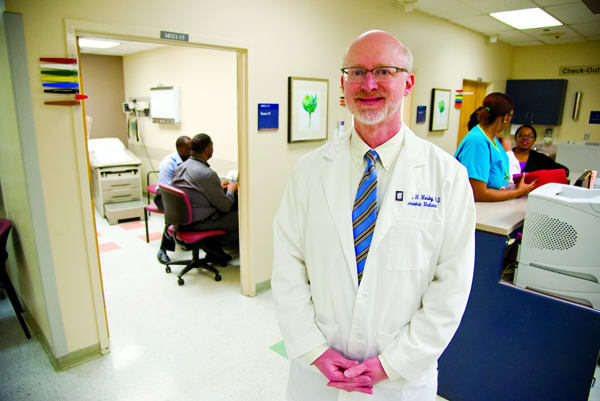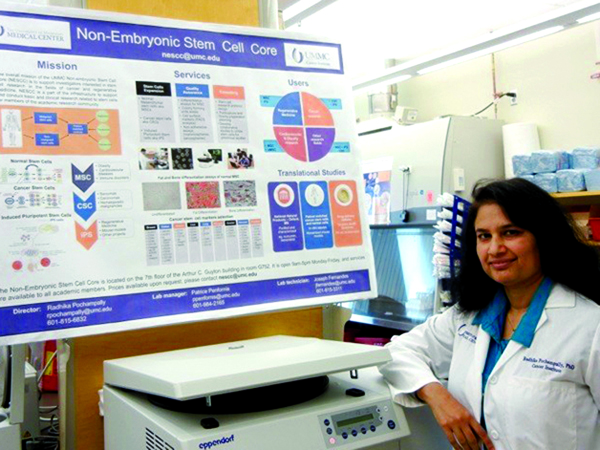ADHD CHILDREN LEARN BETTER THE MORE THEY MOVE, STUDY SUGGESTS

Published on June 01, 2015
A common symptom found in children with attention deficit hyperactivity disorder (ADHD) — and one long believed to be a main hindrance to a child's development — actually could be a learning trigger.
In a study published April 12 in the Journal of Abnormal Child Psychology, researcher Dr. Dustin Sarver and colleagues discovered the hyperactive movements associated with the disorder may allow children with ADHD to enhance their cognitive abilities.
Sarver, who studied the issue while completing his Ph.D. in clinical psychology at the University of Central Florida, now works at the Center for Advancement of Youth (CAY) at the University of Mississippi Medical Center. The findings he helped unearth are ones he said could have an impact on how children with ADHD are taught in classrooms here in Mississippi and the treatments they receive — two of the main goals of the CAY.
"Previous research with my mentor and our colleagues shows that when kids with ADHD are given very demanding cognitive tasks involving working memory, they become more hyperactive. But when we don't put demands on their working memory, they're no more active than kids without ADHD," said Sarver, an assistant professor of pediatrics at UMMC.
"This new research asked the next question — does that movement help or hurt their working memory?"
Working memory, unlike the more commonly known short-term memory, is a higher-level executive function employed when a person must manipulate and process information to arrive at a conclusion, explained Sarver. Working memory is critical for completing complex tasks and learning.
"If I gave you my telephone number, you would use short-term memory to recall it," he said. "If I had you rearrange those same numbers in order, then you're using working memory."
Those were the kinds of tasks children in the UCF study were asked to complete, while researchers observed their movements using high-speed video, he said. For the majority of kids with ADHD, the more they moved the better their working memory performance. In contrast, children without ADHD typically did worse when they moved more.
By allowing the hyperactive behaviors to continue, children with ADHD are able to remain alert in the classroom. Yet conventional teaching and treatment methods demand ADHD children remain still, and the ability to focus on the lesson is lost in the child's struggle to focus on not squirming or fidgeting, said Sarver.
The implications of the study could have a large impact on a state that has more than double the percentage of children diagnosed with ADHD than the national average, said Dr. David Elkin, professor of psychiatry at UMMC and the CAY's executive director.
Elkin said applying Sarver's findings could revolutionize how classrooms operate, how ADHD is understood and how ADHD assessments and treatments are conducted — all potentially saving money while offering more efficient care for these children and their families.
REWIRED BRAIN FINDING LINKED TO POTENTIAL AUTISM TREATMENT

From left, Dr. Kimberly Simpson, Dr. Ryan Darling, Dr. Rick Lin and Dr. Yuegen “Jordan” Lu
A team of Mississippi and California researchers has managed to prove something scientists have hoped to be true about the brain.
It can be rewired.
The research team's findings, published in February in the Proceedings of the National Academy of Sciences (PNAS), could one day translate into an effective treatment for patients with autism spectrum disorders, said the report's co-author Dr. Rick Lin, professor of neurobiology and anatomical sciences at the University of Mississippi Medical Center.
The findings, for now, are limited to the study's test subjects — rats. But the results have proven that these animals' brains can be rewired via intense auditory behavioral training, Lin said.
The intricacies of a brain's wiring remains one of the largest puzzles before scientific researchers.
So when the UMMC team, working with scientists at the University of California in San Francisco, discovered the potential reset button, the discovery immediately roused speculation about the future of autism treatments and outcomes.
The particular test subjects were injected with a drug that stimulated serotonin receptors which in turn induced autistic-like behaviors in the young rats, Lin said.
"The rats, they were just not going to play with one another," Lin said of the test subjects. "Just how a child with autism prefers to play by himself, so were these animals.
"They were also super nervous, and when we would try to excite them with noise, they would just freeze," said Lin. "That's not typical of rats."
Together with UCSF researcher Dr. Michael Merzenich, the teams subjected the rats with the autistic-like behaviors to a specific set of tones and clicks that had proven in other experiments to drive plasticity, the process by which the brain changes over time, said Dr. Ian Paul, UMMC professor of psychiatry and human behavior.
"In your brain, there are cells connected to the nerves running to the ear that respond very precisely to one particular frequency of sound," said Paul, adding that the test rats were hearing the sounds at distorted frequencies and therefore not having typical responses.
"It's almost as if you hear the world completely muffled," explained Paul. "It turns out autistic kids can have some of the same problems."
The study focused on the plasticity of the brain, asking if these neurological distortions could be reversed — or overcome — via simple forms of brain training, said Merzenich.
In a nutshell, said Merzenich: This training had a dramatic impact on all of the autism-like neurological distortions in their brains.
The behavior training took about two months, Lin said. And the results were only prevalent in the male test subjects.
"We know in the general population, there's about four times more boys being diagnosed with autism spectrum disorders than girls. We don't understand why there are sex differences."
The implications for treatment of autism spectrum disorders in humans are present, though researchers caution that could be some time away.
The group's article can be found at: www.pnas.org/content/112/7/2233.
RESEARCHER’S VISION PROMISES TREATMENT FOR EYE TISSUE LOSS

Dr. Richard O’Callaghan
During the six decades that the University of Mississippi Medical Center has been in business, only a select few of these have materialized. But as of December 2014, UMMC was awarded its latest U.S. patent, a testament to years of work and the perseverance of one of its top researchers.
Dr. Richard O'Callaghan, chair of microbiology, has been researching eye infections since the 1980s when he was a faculty member at Louisiana State University Health Sciences Center in New Orleans. Once he arrived at UMMC about a decade ago, he continued his work looking into the damaging effects of Staphylococcus, a bacteria, and its threat to patients' vision.
Now O'Callaghan can hold in his hands the tangible evidence of his research: a U.S. patent for "Inhibitors of Alpha-toxin."
Alpha-toxins are damaging proteins secreted by Staphylococcus, wreaking havoc on the eye's tissue. The inhibitors, cholesterol bound to a sugar complex, block the alpha-toxin action on cells, rendering them harmless, O'Callaghan said.
The patent could lead to the creation of new treatments that can reduce the amount of eye tissue damage caused by Staphylococcus.
"It can be used as eye drops to stop the toxin while antibiotic eye drops kill the bacteria," O'Callaghan said.
The next step in the process is getting a pharmaceutical company interested in the patented treatment, and then, much later, human trials could be conducted.
O'Callaghan's patent marks the third awarded to UMMC during the last few years, and is one of more than a dozen received by the Medical Center throughout its entire existence.
THINKING SKILLS GENE MAY HELP DECODE ALZHEIMER’S

Dr. Tom Mosley
An international team of researchers, including investigators from UMMC, has linked a specific genetic mutation and information processing speed.
Identifying the gene is a first step to understanding cognitive aging and age-related diseases, such as Alzheimer's disease.
The study, published April 14 in the journal Molecular Psychiatry, is the largest genetics study to date to establish this link.
"The genes that underlie thinking skills remain largely unknown," said Dr. Tom Mosley, director of the Memory Impairment Neurodegenerative Dementia (MIND) Center at UMMC and senior scientist on the study.
"Our team has identified a genetic mutation that may help unravel this puzzle."
The effort was conducted through the Cohorts for Heart and Aging Research in Genomic Epidemiology (CHARGE) consortium, in which researchers from around the world work together to search for genetic causes of disease in the general aging population.
Dr. Carla Ibrahim-Verbaas, a resident in neurology at Erasmus University Medical Center in Rotterdam, The Netherlands, was the lead author on the study.
Previous studies in families and in twins have shown genetics play an important role in cognitive functioning, but finding the specific genes or genetic regions has proved difficult, requiring a combination of large sample sizes and detailed genetic measurements.
But in this case, researchers analyzed data from more than 30,000 people who were 45 or older, bringing together genetic and cognitive functioning data from participants in several studies in 12 different countries.
In addition, they examined genetic variations across 2.5 million sites along each individual's DNA, looking for associations between genetic variants and performance on several different tests of cognitive function.
"We now have the technology to measure across the entire genome in a much more fine-grained manner compared to a few years ago, in this case 2.5 million sites, and are able to combine that genetic mapping with large sample sizes," Mosley said.
"The collaboration of leading scientists from around the world, who have agreed to pool their data and analytic resources, is significantly enhancing our ability to identify genes related to complex brain functions and disease."
The core CHARGE cohorts include five population-based studies, including the Atherosclerosis Risk in Communities study, AGES-Reykjavik Study, Framingham Heart Study, Cardiovascular Health Study, and the Rotterdam study. Funding for the cohorts was provided by the National Institutes of Health.
The study can be found at www.nature.com/mp/journal/vaop/ncurrent/abs/mp201537a.html.
CANCER RESEARCHERS PROBE STEM CELLS’ ROLE IN BREAST, BONE DISEASE

Dr. Radhika Pochampally
Researchers at the University of Mississippi Medical Center's Cancer Institute are moving into new arenas with the formation of a Non-Embryonic Stem Cell Core.
Led by cancer researcher Dr. Radhika Pochampally, the core - a laboratory where researchers with multiple interests can go for specific experiments - will work with various researchers in cancer, heart and other areas to study stem cells and their role in disease and illness.
For cancer studies, the initial focus is on breast and bone cancers, Pochampally said.
"Most of the time, the primary cancer can be treated," she said. "The cells that survive treatments for primary cancers go into dormancy, and then come back - these are the bad cells, the most difficult to kill."
Bad? Yes, because those cancer stem cells have the ability to lie low for a long time, roam a person's body, find a home in another organ and reproduce more malignant cells. Chemotherapy drugs may destroy other tumor cells, but now scientists know that sometimes a few - the cancer stem cells - may remain.
Even more confusing, this scenario doesn't happen all the time, so researchers want to find out when and why it occurs in some people and not others.
The new core is seeking permission to ask cancer patients for samples of their normal tissue and malignant tissue. Pochampally said if the UMMC Institutional Review Board agrees, her team will use the samples to search for the difference between the normal stem cells and the malignant ones.
On the surface, she said, normal and malignant stem cells from one person may look the same.
"If you go down deeper, they look very different."
If researchers here can find minuscule differences, then they'll work with colleagues at the National Center for Natural Products Research at the University of Mississippi in Oxford to find a drug that targets a vulnerable area on the cancer stem cells and leaves normal healthy cells alone.


